 Kia Rio: Inspection
Kia Rio: Inspection
Camshaft Assembly
|
1. |
Inspect the cam height.
Using a micrometer, measure the cam height.
Cam height
Intake : 44.15mm (1.7382in)
Exhaust : 43.55mm (1.7146in)
|
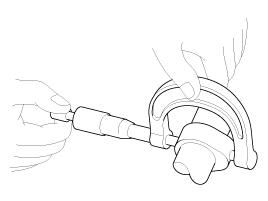
If the cam lobe height is less than specified, replace the camshaft.
|
|
2. |
Check the cranshaft journal for wear.
If the journal is worn excessively, replace the camshaft.
|
|
3. |
Inspect the camshaft journal clearance.
|
(1) |
Clean the bearing caps and camshaft journals.
|
|
(2) |
Place the camshafts on the cylinder head.
|
|
(3) |
Lay a strip of plastigage across each of the camshaft
journal.
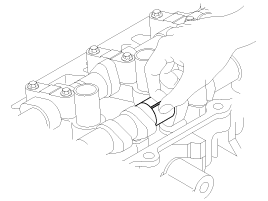
|
|
(4) |
Install the bearing caps and tighten the bolts with specified
torque.
Tightening torque
1st step
M6 bolt : 5.9 N.m (0.6 kgf.m, 4.3 lb-ft)
M8 bolt : 9.8 N.m (1.0 kgf.m, 7.2 lb-ft)
2nd step
M6 bolts : 11.8 ~ 13.7N.m (1.2 ~ 1.4kgf.m, 8.7
~ 10.1lb-ft)
M8 bolts : 18.6 ~ 22.6N.m (1.9 ~ 2.3kgf.m, 13.7
~ 16.6lb-ft)
|
|
Do not turn the camshaft.
|
|
|
(5) |
Remove the bearing caps.
|
|
(6) |
Measure the plastigage at its widest point.
Bearing oil clearance
Standard :
0.027 ~ 0.058 mm (0.0011 ~ 0.0023 in)
Limit : 0.1 mm ( 0.0039 in)
|
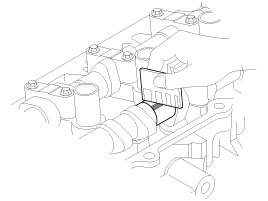
| A. |
If the oil clearance is greater than specified,
replace the camshaft.
|
| B. |
If necessary, replace the bearing caps and cylinder
head as a set.
|
|
|
|
4. |
Inspect the camshaft end play.
|
(1) |
Install the camshafts.
|
|
(2) |
Using a dial indicator, measure the end play while moving
the camshaft back and forth.
Camshaft end play
Standard : 0.1 ~ 0.2 mm (0.0039 ~ 0.0079 in)
|
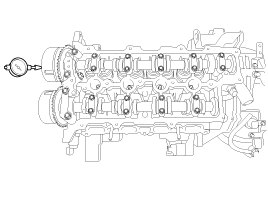
| A. |
If the end play is greater than specified, replace
the camshaft.
|
| B. |
If the end play is still greater than specification
after camshaft replacment, replace the bearing caps
and cylinder head as a set.
|
|
|
(3) |
Remove the camshafts.
|
|
CVVT (Continuously Variable Valve Timing) Assembly
|
1. |
Inspect the CVVT for smooth rotation.
|
(1) |
Clamp the camshaft using a vise. Be careful not to damage
the cam lobes and journals in the vise.
|
|
(2) |
Check that the CVVT is locked by turning it clockwise
or counterclockwise. It must not rotate.
|
|
(3) |
Intake CVVT : Seal one of the two advance holes in the
camshaft journal with tape.
Exhaust CVVT : Seal one of the two retard holes in the
camshaft journal with tape.
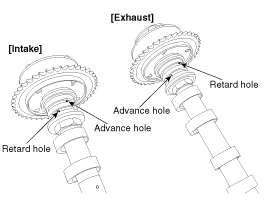
|
|
(4) |
Intake CVVT : Apply approx. 150 kPa (1.5 kgf/cm², 21 psi
) of compressed air into the unsealed advance hole to release
the lock.
Exhaust CVVT : Apply approx. 150 kPa (1.5 kgf/cm², 21
psi ) of compressed air into the unsealed retard hole to release
the lock.
|
Cover the oil paths with a piece of cloth when
applying compressed air to prevent oil from spraying.
|
|
|
(5) |
Intake CVVT : With compressed air applied, rotate the
CVVT into the advance direction (counterclockwise) within its
phasing range and check that the CVVT turns smoothly.
Exhaust CVVT : With compressed air applied, rotate the
CVVT into the retard direction (clockwise) and check that the
CVVT turns smoothly.
CVVT phasing range
Intake : 25┬░┬▒1┬░ (from the most retarded position
to the most advanced position)
Exhaust : 20┬░┬▒1┬░ (from the most advanced position
to the most retarded position)
|
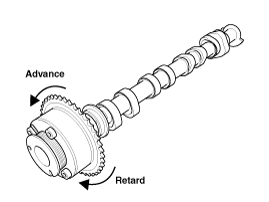
|
|
(6) |
Intake CVVT : Rotate the CVVT into the most retarded position
(clockwise) and then check that the CVVT is locked.
Exhaust CVVT : Rotate the CVVT into the most advanced
position (counterclockwise) and then check that the CVVT is
locked.
|
|
1.
Remove the cyliner head cover.
(Refer to Timing System)
2.
Remove the timing chain cover.
(Refer to Timing System)
...
1.
Install the intake CVVT (A) and exhaust CVVT (B).
Tightening torque :
63.7 ~ 73.5 N.m (6.5 ~ 7.5 kgf.m, 47.0 ~ 54.2 lb-ft)
...
See also:
Oil Pump Description
The oil pump is built-in as a single unit with the 26 brake chamber. Rotation
of the pump builds the hydraulic pressure needed for the lubrication of the
various parts of the transaxle and op ...
Rear Bumper Components
[5 Door]
1. Rear bumper cover
2. Rear bumper side bracket [RH]
3. Rear bumper side bracket [LH]
4. Rear bumper side under cover
[4 Door]
...
Special Service Tools
Tool(Number and Name)
Illustration
Use
09495-3K000
Band installer
Installation of ear type boot band
09495-33000
Puller
...
 Kia Rio: Inspection
Kia Rio: Inspection Removal
Removal Installation
Installation







